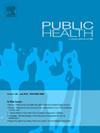Investigating the contextual drivers and factors impacting child growth failure in mining communities: A Structural Equation Modeling approach
IF 3.9
3区 医学
Q1 PUBLIC, ENVIRONMENTAL & OCCUPATIONAL HEALTH
引用次数: 0
Abstract
Objective
To investigate contextual drivers impacting child growth-failure.
Study design
Employed a cross-sectional study design.
Methods
The study Comprised a random sample of 781 under-five children and their caregivers. Structured interviews were conducted with caregivers, and anthropometric measurements were taken from the children. Bivariate chi-square, Structural Equation Modeling and multivariate logistic regression analyses were performed.
Results
Over half (51 %) of the children were female. On average, households consisted of 6.1 ± 2.7 SD persons. Primary caregivers had an average age of 24.2 ± 9.4 while the children's average age was 21.3 ± 15.7 SD months. The average height of children was 80.4 ± 13.7 SD with a height-for-age Z-Score of 0.2 ± 4.9 SD. Further, 35 % of children experience child growth failure. Drivers include; age-caregiver [AOR = 1.04, 95 % CI = 1.028–1.056], high-school education [AOR = 0.24, 95 % CI = 0.089–0.677], unemployment-housewife [AOR = 0.45, 95 % CI = 0.226–0.901], feeding-strategies [AOR = 0.39, 95 % CI = 0.226–0.663] and cooking-duration [AOR = 2.16, 95 % CI = 1.131–4.129].
Conclusion
Child growth failure remains a concern, with individual and contextual-level factors identified as significant contributors and thus crucial to take them into account when designing nutrition interventions in vulnerable communities.
研究影响采矿社区儿童成长失败的背景驱动因素:结构方程建模方法
目的探讨影响儿童生长衰竭的环境因素。研究设计采用横断面研究设计。方法随机抽样调查781名5岁以下儿童及其照顾者。与护理人员进行了结构化访谈,并对儿童进行了人体测量。采用双变量卡方、结构方程模型和多变量logistic回归分析。结果半数以上(51%)患儿为女性。每户平均有6.1±2.7名特别残疾人士。主要照顾者的平均年龄为24.2±9.4个月,儿童的平均年龄为21.3±15.7个月。儿童平均身高为80.4±13.7 SD,年龄-身高Z-Score为0.2±4.9 SD。此外,35%的儿童经历过儿童成长失败。驱动程序包括:年龄照顾者[AOR = 1.04, 95% CI = 1.028 ~ 1.056]、高中学历[AOR = 0.24, 95% CI = 0.089 ~ 0.677]、失业家庭主妇[AOR = 0.45, 95% CI = 0.226 ~ 0.901]、喂养策略[AOR = 0.39, 95% CI = 0.226 ~ 0.663]和烹饪时间[AOR = 2.16, 95% CI = 1.131 ~ 4.129]。结论儿童生长衰竭仍然是一个值得关注的问题,个体和环境层面的因素被认为是重要的影响因素,因此在设计脆弱社区的营养干预措施时,将它们考虑进去至关重要。
本文章由计算机程序翻译,如有差异,请以英文原文为准。
求助全文
约1分钟内获得全文
求助全文
来源期刊

Public Health
医学-公共卫生、环境卫生与职业卫生
CiteScore
7.60
自引率
0.00%
发文量
280
审稿时长
37 days
期刊介绍:
Public Health is an international, multidisciplinary peer-reviewed journal. It publishes original papers, reviews and short reports on all aspects of the science, philosophy, and practice of public health.
 求助内容:
求助内容: 应助结果提醒方式:
应助结果提醒方式:


